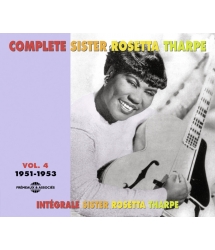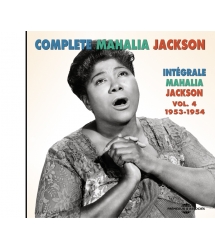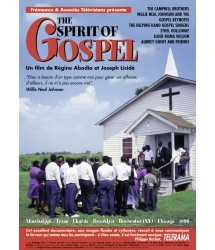- Our Catalog
- Philosophy
- Philosophers of the 20th century and today
- History of Philosophy (PUF)
- Counter-History and Brief Encyclopedia by Michel Onfray
- The philosophical work explained by Luc Ferry
- Ancient thought
- Thinkers of yesterday as seen by the philosophers of today
- Historical philosophical texts interpreted by great actors
- History
- Books (in French)
- Social science
- Historical words
- Audiobooks & Literature
- Our Catalog
- Jazz
- Blues
- Rock - Country - Cajun
- French song
- World music
- Africa
- France
- Québec / Canada
- Hawaï
- West Indies
- Caribbean
- Cuba & Afro-cubain
- Mexico
- South America
- Tango
- Brazil
- Tzigane / Gypsy
- Fado / Portugal
- Flamenco / Spain
- Yiddish / Israel
- China
- Tibet / Nepal
- Asia
- Indian Ocean / Madagascar
- Japan
- Indonesia
- Oceania
- India
- Bangladesh
- USSR / Communist songs
- World music / Miscellaneous
- Classical music
- Composers - Movie Soundtracks
- Sounds of nature
- Our Catalog
- Youth
- Philosophy
- News
- How to order ?
- Receive the catalog
- Manifesto
- Dictionnary











- Our Catalog
- Philosophy
- Philosophers of the 20th century and today
- History of Philosophy (PUF)
- Counter-History and Brief Encyclopedia by Michel Onfray
- The philosophical work explained by Luc Ferry
- Ancient thought
- Thinkers of yesterday as seen by the philosophers of today
- Historical philosophical texts interpreted by great actors
- History
- Books (in French)
- Social science
- Historical words
- Audiobooks & Literature
- Our Catalog
- Jazz
- Blues
- Rock - Country - Cajun
- French song
- World music
- Africa
- France
- Québec / Canada
- Hawaï
- West Indies
- Caribbean
- Cuba & Afro-cubain
- Mexico
- South America
- Tango
- Brazil
- Tzigane / Gypsy
- Fado / Portugal
- Flamenco / Spain
- Yiddish / Israel
- China
- Tibet / Nepal
- Asia
- Indian Ocean / Madagascar
- Japan
- Indonesia
- Oceania
- India
- Bangladesh
- USSR / Communist songs
- World music / Miscellaneous
- Classical music
- Composers - Movie Soundtracks
- Sounds of nature
- Our Catalog
- Youth
- Philosophy
- News
- How to order ?
- Receive the catalog
- Manifesto
- Dictionnary
INTEGRALE 1953 - 1957
Ref.: FA1305
Artistic Direction : JEAN BUZELIN
Label : Frémeaux & Associés
Total duration of the pack : 1 hours 44 minutes
Nbre. CD : 2
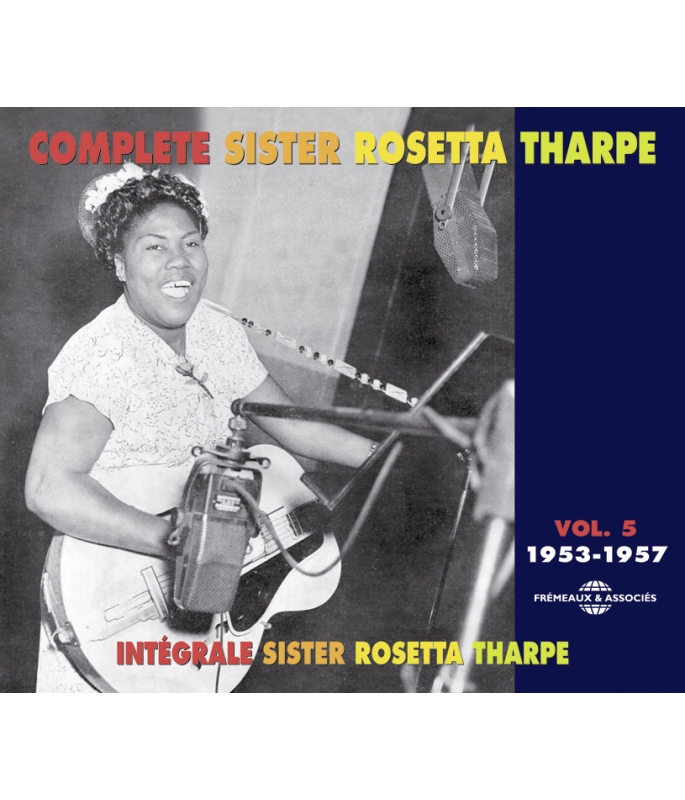
INTEGRALE 1953 - 1957
INTEGRALE 1953 - 1957
She was so strong in her convictions. She didn’t let nobody change her around. She just believed that what she was doing was what God had given her. Ruth Brown

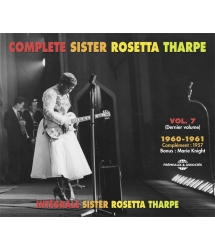
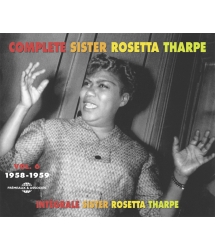
-
PisteTitleMain artistAutorDurationRegistered in
-
1Stand The StormTharpe Sister Rosetta00:02:311953
-
2Sing And ShoutTharpe Sister Rosetta00:03:201953
-
3ShadrackTharpe Sister Rosetta00:02:081953
-
4Nobody's FaultTharpe Sister Rosetta00:02:241953
-
5I'm So GladTharpe Sister Rosetta00:02:501953
-
6God Spoke To MeTharpe Sister Rosetta00:03:081953
-
7CalvaryTharpe Sister Rosetta00:02:441953
-
8I Tell It Whereever I GoTharpe Sister Rosetta00:02:241953
-
9This Old Soul Of MineTharpe Sister Rosetta00:03:051953
-
10Don't Leave Me Here To CryTharpe Sister Rosetta00:03:071953
-
11What Have I DoneTharpe Sister Rosetta00:02:551953
-
12Go AheadTharpe Sister Rosetta00:02:261954
-
13He Is Everything To MeTharpe Sister Rosetta00:02:121954
-
14Everytime I Feel The SpiritTharpe Sister Rosetta00:02:201954
-
15Look Away In The Heavenly LandTharpe Sister Rosetta00:01:471956
-
16When Was Jesus BornTharpe Sister Rosetta00:02:071956
-
17In BethlehemTharpe Sister Rosetta00:03:051954
-
18This Ole HouseTharpe Sister Rosetta00:02:501954
-
19Don't You Weep O Mary Don't You WeepTharpe Sister Rosetta00:02:301956
-
20I've Done WrongTharpe Sister Rosetta00:02:451956
-
21I'v an Hear The AngelsTharpe Sister Rosetta00:02:591956
-
22Father Prepare MeTharpe Sister Rosetta00:02:111956
-
PisteTitleMain artistAutorDurationRegistered in
-
1Two Little Fishes, Five Loaves Of BreadTharpe Sister Rosetta00:02:371956
-
2All AloneTharpe Sister Rosetta00:02:401956
-
3How About YouTharpe Sister Rosetta00:03:331956
-
499 1/2 Won't DoTharpe Sister Rosetta00:02:001956
-
5Precious MemoriesTharpe Sister Rosetta00:02:421956
-
6Beams Of HeavenTharpe Sister Rosetta00:03:251956
-
7When The Saints Go Marching InTharpe Sister Rosetta00:02:231956
-
8Cain't No Grave Hold May Body DownTharpe Sister Rosetta00:02:431956
-
9When They Ring The Golden BellsTharpe Sister Rosetta00:02:321956
-
10Up Above My Head There's Music In The AirTharpe Sister Rosetta00:02:281956
-
11I Shall Know HimTharpe Sister Rosetta00:02:301956
-
12Fly AwayTharpe Sister Rosetta00:02:271956
-
13JerichoTharpe Sister Rosetta00:02:061956
-
14Home In The SkyTharpe Sister Rosetta00:02:531956
-
15Can't Do Wrong And Get ByTharpe Sister Rosetta00:02:401956
-
16Let's Be HappyTharpe Sister Rosetta00:02:211957
-
17Let It ShineTharpe Sister Rosetta00:02:001957
-
18Didn't It Rain ChildrenTharpe Sister Rosetta00:03:071952
COMPLETE SISTER ROSETTA THARPE
INTÉGRALE SISTER ROSETTA THARPE VOL. 5
1953-1957
Deux années après son mariage en grandes pompes dont l’impact, au-delà de l’événement, ne semble pas avoir été à la hauteur des espoirs qu’il pouvait susciter, Sister Rosetta Tharpe traverse une période un peu creuse, commercialement parlant. La première depuis ses fracassants débuts quinze ans auparavant. Certes, l’année précédente, les portes des studios de Nashville(1) lui ont été ouvertes, et son duo avec le chanteur Red Foley l’a fait connaître dans un milieu, celui de la country music, où les artistes de couleur n’entrent pas facilement. Mais à côté du symbolisme de la rencontre – un duo mixte noir et blanc n’était pas courant à l’époque –, il n’y avait pas grand-chose à espérer musicalement de l’association. D’ailleurs, compte tenu de l’insuccès commercial du disque, les auditeurs, quel qu’ils soient, ne s’y sont pas retrouvés. Ceci dit, guitare en bandoulière, Sister Rosetta Tharpe continue à électriser le public qu’elle rassemble, partout où elle va porter la bonne parole, des petites églises jusqu’aux grands music-halls. Elle est souvent accompagnée par sa consœur Marie Knight dont la carrière suit à peu près le même profil. Elles participent ensemble, entre autres, à un grand concert au Booker T. Washington Auditorium de la Nouvelle-Orléans. Toujours associées pour le meilleur, les deux chanteuses se retrouvent une fois de plus en studio au mois d’octobre 1953. Ensemble et alternativement, elles enregistrent une dizaine de titres de haut niveau(2). Notons en particulier, deux pièces enlevées et exubérantes, Stand The Storm et Shadrack, au swing contagieux. Le jeu de guitare de Rosetta, bluesy à souhait, se remarque particulièrement dans I’m So Glad et dans Sing And Shout où la chanteuse dialogue cette fois avec elle-même. Fait exceptionnel, Rosetta Tharpe aurait joué de la guitare durant les interprétations chantées par Marie Knight seule. Or, à l’audition des quatre faces, la présence de l’instrument n’est guère audible ; tout juste peut-on deviner, parfois, un sobre accompagnement en accords. Malgré une écoute attentive en studio, nous n’avons pu trancher et avons opté pour une présence possible et discrète qui nous permet de proposer ces quatre morceaux aux auditeurs que nous espérons indulgents. En effet, sans parler de leur rareté, ils sont d’une qualité telle qu’il aurait été un peu dommage de les écarter, Marie Knight étant alors vocalement à son sommet. Dans le doute, ne nous abstenons pas !.. Pour relancer sa carrière phonographique qui, malgré tout, ne redécolle pas, les producteurs de chez Decca tentent un coup : réintroduire la chanteuse dans le circuit séculier du Rhythm & Blues. Pour avoir suivi autrefois les démêlés de la chanteuse avec les autorités religieuses, du temps où elle triomphait sur les grandes scènes du jazz et de l’entertainment, considérons que le coup était risqué. Rosetta avait renoncé depuis des années à interpréter un répertoire profane. Sous la houlette de Leroy Kirkland, un arrangeur et chef d’orchestre noir réputé et particulièrement actif dans les studios new-yorkais, elle grave donc quelques chansons(3) à la mode R&B, mais qui, nonobstant l’accompagnement musical, le rythme plus appuyé et les paroles bien sûr, ne tranchent guère avec sa manière habituelle. De toutes façons, cette ouverture “risquée“ se referme vite pour la bonne et simple raison que le disque édité (en 78 et 45 tours), pourtant bien promu et édité dans les popular series, ne rencontre guère le succès. Malgré tout, Rosetta et Marie Knight mettent à leur programme leurs chansons profanes. Durant leurs tournées communes en 1954 et 1955, elles sont parfois rejointes par la chanteuse Sister Wynona Carr, qui eut quelques succès dans le Gospel au début des années 50(4) mais qui va, elle aussi, franchir le pas vers le rhtyhm and blues, et ce définitivement en 1956.
En été 1954, Sister Rosetta Tharpe retrouve, pour la première fois depuis trois ans et demi en studio, son vieux partenaire Sammy Price avec qui elle a toujours eu des rapports houleux. Ce qui n’a pas empêché la chanteuse de réaliser avec ce maître pianiste quelques-uns de ses meilleurs disques. Elle revient vers les gospel songs avec quatre pièces superbes dont un Go Ahead, rempli de soul, une reprise d’un thème des Swan Silvertones. Les trois autres morceaux, sur des tempos rapides, comprennent de nombreux chorus de guitare, et Look Away est chanté en duo avec Marie Knight. Cette séance est la dernière où l’on peut entendre les deux chanteuses ensemble. C’est aussi l’ultime fois où Sammy Price accompagnera Rosetta. Laquelle, posant son instrument, chante trois thèmes traditionnels en compagnie d’un chœur dirigé par Sy Oliver. Deux titres sont allègrement enlevés, avec des solos de Price et de l’organiste Marlowe Morris, la troisième, In Bethlehem, est une spiritual waltz un peu grandiloquente. Ces interprétations sont sans doute orientées vers un nouveau public, blanc, qui commence à découvrir Rosetta Tharpe au moment même où sa popularité faiblit auprès de sa communauté. Paradoxe apparent maintes fois soulevé et vérifié auprès de nombreux artistes afro-américains durant cette décennie de tous les changements. En effet, une nouvelle génération apparaît aux Etats-Unis, ce qui se traduit, sur le “marché”, par de profondes mutations. Le rock ‘n’ roll est en train de pointer le bout de son nez, et une sorte de “jeunisme” s’empare des nouveaux consommateurs, les teenagers. Ceux-ci, aussi bien Noirs que Blancs, s’entichent des vedettes poussées comme des champignons qui ont le même âge que leur public. (On constate, cinquante ans plus tard, que le phénomène a persisté). Exit les stars du R&B, du Gospel, de la Country qui ont l’âge de papa et de maman. Où celles-ci s’adaptent, modifient leur style ou changent de circuit musical en recherchant d’autres publics, où elles disparaissent corps et bien. Le circuit du jazz, celui de la pop music (la grande variété américaine), et un nouveau cercle d’amateurs, essentiellement blancs, universitaires, cultivés et libéraux, prennent le relais d’une société noire qui, à l’aube des grands mouvements de revendication des droits civiques, cherche à couper avec ses racines qu’elle juge humiliantes et trop liées à la ségrégation raciale. Dans le domaine de la musique sacrée, Mahalia Jackson vient de montrer la voie en signant avec Columbia, major company qui lui offre des ouvertures insoupçonnées(5). Un passage des deux chanteuses (Rosetta et Marie) au Village Vanguard, le célèbre club de New York, en février 1955, est signalé dans le magazine Variety ; un concert « From Spirituals to Swing » organisé par John Hammond, et où se produit Rosetta, fait l’objet d’un compte-rendu du critique Nat Hentoff dans Down Beat. Le nom de Sister Rosetta Tharpe commence donc à circuler parmi ces nouveaux publics, et jusqu’en Europe où, en mai 1956 dans la revue Jazz Hot (N°110), Jacques Demêtre écrit le premier article important consacré en France à cette chanteuse dont le nom n’était alors connu que d’une poignée d’amateurs éclairés(6). C’est durant cette même année, en février, que Rosetta franchit pour la dernière fois les portes des studios Decca sur la West 50nd Street où elle n’a pas mis les pieds depuis un an et demi. L’heure est arrivée où son contrat expire avec la maison de disques qui a accompagné toute sa carrière depuis 1938. Elle retrouve, en la circonstance, ses amis de Richmond, les Harmonizing Four, alors sur les pentes de l’ascension. Dans ces quatre morceaux de fort bonne tenue, l’excellent guitariste Everett Barksdale intervient fort à propos.
L’excellent quartette vocal des Harmonizing Four est à nouveau convoqué quelques mois plus tard à l’occasion des débuts de Sister Rosetta Tharpe chez Mercury. Car, après Marie Knight qui l’a précédé en studio au mois de mai, la chanteuse vient de signer avec cette maison de Chicago, fondée en 1946, qui produit des artistes renommés comme Dinah Washington. Vedette de la marque, le “Reine” obtient d’excellents résultats auprès d’un large public tout en maintenant une base solide auprès de la communauté noire(7). Mercury vient également, l’année précédente, de décrocher le jack pot avec Only You des Platters qu’ils venaient d’engager. Avec Rosetta Tharpe, Mercury opère un peu de la même façon que Columbia avec Mahalia Jackson : les producteurs lui font réenregistrer quelques-uns de ses plus grands succès en vue de les réunir sur un album 33 tours, et toucher ainsi une clientèle qui n’a jamais acheté ses anciens 78 tours Decca. Rosetta est entourée d’un excellent combo jazzy qui comprend quelques piliers des studios new-yorkais ; se distinguent particulièrement l’organiste Doc Bagby et Ernest Richardson qui tisse de beaux contre-chants à la guitare. L’autre guitare est tenue bien en mains par Rosetta elle-même qui s’offre quelques bonnes interventions sur les morceaux up-tempo comme When The Saints Go Marching In ou Up Above My Head dans lequel la grande basse Jimmy Jones, fraîchement entrée chez les Harmonizing Four, intervient en lead vocal. Sur les treize plages mises sur bande durant cette session de deux jours, seul When The Saints est écarté de l’album intitulé « Gospel Train ». Il ne sera publié qu’en 45 tours, jumelé avec Cain’t No Grave Hold My Body Down, tiré lui de l’album.
Après cet éventail de morceaux choisis, Rosetta va participer à deux autres séances où son chant va s’inscrire sur des rythmes parfois “actualisés” ; ainsi Let’s Be Happy est chanté sur un rythme de boléro. Mais la chanteuse-guitariste retrouve son meilleur niveau dans les pièces plus échevelées comme Can’t Do Wrong And Get By et le traditionnel Let It Shine. Quatre titres sont enregistrés en octobre 1956, quatre autres en juin 1957(8). La chanteuse n’a pas perdu la foi ! Et pourtant, à ce moment même, elle connaît de sérieux soucis financiers dont son mari Russell Morrison, du genre dépensier, n’est peut-être pas le moindre responsable. Elle doit alors vendre sa maison de Richmond, le bus qui lui sert pour ses déplacements, elle envisage même de divorcer… Et le couple se retrouve dans une chambre d’hôtel à Philadelphie. À cette situation pénible succède, bienheureusement, un événement qui va marquer le départ d’une nouvelle étape de son existence. Après une tournée fructueuse dans les églises et salles de concert du pays, Sister Rosetta Tharpe s’envole le 19 novembre pour l’Angleterre, pays où Mahalia Jackson n’avait été que tièdement accueillie en 1952… Mais avant que la suite de cette histoire nous soit contée en musique dans le prochain volume de notre intégrale, opérons un petit retour en arrière avec un document qui nous avait échappé dans la chronologie de son œuvre enregistrée : un extrait d’un passage de la chanteuse à l’Apollo de Harlem au début des années 50(9). Ce sera notre “bonus”.
Jean BUZELIN
Auteur de Negro Spirituals & Gospel Songs, Chants d’espoir et de liberté (Éd. du Layeur/Notre Histoire, Paris 1998)
© 2008 FRÉMEAUX & ASSOCIÉS/Groupe Frémeaux Colombini SAS
Notes :
(1) Les enregistrements de 1952 présentés dans le Vol. 4 (FA 1304) ont été réalisés à Nashville (Tennessee) et non à New York comme indiqué dans la discographie.
2) Un titre est resté inédit : All The Good We Can Do (85397). Par ailleurs, nous avons exceptionnellement dérogé à la stricte chronologie des numéros de matrice pour ne pas commencer par I’m So Glad, Cette face usée provient du seul exemplaire connu d’un rare 78 tours que nous a prêté notre ami autrichien Daniel Gugolz.
3) Si un seul disque a été publié, il est possible que d’autres titres soient restés au fond des tiroirs. Lors de cette session, Marie Knight a également enregistré des morceaux R&B.
4) Cf. Gospel, Sisters & Divas (FA 5053).
5) Cf. Complete Mahalia Jackson Vol. 5 (FA 1315).
6) Parmi lesquels Sim Copans, Hugues Panassié et Jacques Morgantini. Par ailleurs, un 45 tours et un microsillon ont été publiés en France en 1954. Il ne faut non plus pas oublier le fait que Sister Rosetta Tharpe rencontra le public blanc dans les revues du Cotton Club, puis lors du fameux concert « From Spirituals to Swing » au Carnegie Hall en 1938 et, dans la période qui suivit, lors de ses passages au Café Society de New York.
7) Cf. Dinah Washington, The Queen (FA5209)
8) Quatre titres n’ont jamais été publiés : O Little Town Of Bethlehem (13752), So High, So Low (13753), I’m Gonna Take A Trip On That Old Ship (15353) et Honor (15355)
9) Publié in CD Let’s Have A Ball Tonight (Natasha Imports NI-4025).
Ouvrage consulté :
Gayle F. Wald, Shout, Sister, Shout ! Beacon Press, Boston 2007) ; la vie de Sister Rosetta Tharpe dont la lecture est chaudement recommandée. Nous remercions chaleureusement Daniel Gugolz (avec Hans Mainer et Fritz Mülhocker), Jacques Morgantini et Gayle Wald pour le prêt de disques 78 et 45 tours de leur collection, ainsi que Robert Laughton et François-Xavier Moulé. Photos et collections : Jazz Festival Society of America, Jean Buzelin, Jacques Morgantini, X (D.R.)
english notes
Two years after her wedding extravaganza which, apart from the event itself, does not seem to have had the hoped-for impact, Sister Rosetta Tharpe’s commercial career entered a rather slack period. The first since her sensational debut fifteen years previously. It is true that the Nashville studios(1) had opened their doors to her the previous year, and her duo with singer Red Foley had made her name in country music, a milieu where it wasn’t easy for coloured artistes to make a mark. However, apart from the symbolism inherent in this encounter – a mixed race duo was unusual at the time – there was not a great deal to hope for musically from such an association. Moreover, the record’s lack of commercial success did not attract many listeners. In spite of this, guitar slung across her shoulder, Sister Rosetta Tharpe continued to electrify her public wherever she appeared, from small churches to well known music halls. She was frequently accompanied by her co-star Marie Knight whose career followed approximately the same path. Together they took part in a big concert at the Booker T. Washington Auditorium in New Orleans and, as successfully as ever, they were both back in the recording studios in October 1953. Together and separately they cut a dozen excellent titles(2). Particularly worthy of note are two lively and exuberant pieces Stand The Storm and Shadrack that swing contagiously. Rosetta’s bluesy guitar is especially outstanding on I’m So Glad and Sing And Shout on which the singer dialogues with herself and exceptionally she appears to play guitar behind Marie Knight’s solo vocals. Even listening very carefully to these latter four sides, the guitar is barely audible but one can occasionally catch an unobtrusive chord accompaniment. In spite of further very close listening in the studio we could not be sure and so we decided that Rosetta was possibly present, albeit discreetly, and decided to include these four titles. In fact, apart from their rarity, Marie Knight is so good on them that it would have been a pity to exclude them. When in doubt don’t hesitate! In order to relaunch her recording career that was still not really taking off, Decca decided to try something new: reintroduce the singer onto the secular Rhythm & Blues circuit. We already know the problems she had had with religious bodies following her success in the jazz and entertainment field so this was more than a little risky. It was years since Rosetta had abandoned her secular repertoire. Under the direction of the well known black arranger and bandleader Leroy Kirkland, who worked regularly in the New York studios, she recorded several songs(3) in a R&B style but on which, notwithstanding the musical accompaniment, the more pronounced rhythm and of course the lyrics were very different from what she usually produced. In any case, this risky idea was soon discarded, not least as the record (on 78s and 45s), although well promoted and issued in the popular series, had little success. Nevertheless, Rosetta and Marie Knight included their secular songs in their programme. During their joint tours in 1954 and 1955 they were sometimes joined by singer Sister Wynona Carr who, after some success in Gospel during the early 50s(4), would also finally move over to rhythm and blues in 1956. In the summer of 1954, for the first time in three and a half years, Sister Rosetta Tharpe teamed up again in the studios with her old partner Sammy Price. Although their relationship had always been a tempestuous one this did not prevent her from producing some of her best records with him. She returned to Gospel with four superb titles including a soulful Go Ahead, reprised from a theme by the Swan Silverstones. The other three titles, up tempo, include numerous guitar choruses and Look Away is sung in duo with Marie Knight. This session is the last one where the two vocalists are heard together. It was also the last time Sammy Price accompanied Rosetta who, without her guitar, sings three traditional songs backed by a choir led by Sy Oliver. Two titles are slightly livelier with solos from Price and organist Marlowe Morris, while the third In Bethlehem is a somewhat grandiose spiritual waltz. It is clear that these interpretations were aimed at a new white audience that was just beginning to discover Rosetta at the very moment her popularity was fading with her own people. This seeming paradox was typical of what was happening to numerous black artistes during this decade when everything was changing. The fact that a new generation was emerging in the United States could be seen in profound market changes. Rock ‘n’ roll was making its first tentative appearance and a sort of “youth movement” took hold of teenagers who, both black and white, were becoming besotted with an increasing number of stars who were the same age as themselves. (The same phenomenon is still apparent fifty years on). Exit Rhythm & Blues, Gospel and country stars as old as their parents. Either these latter adapted, changed their styles or their musical circuits in search of new audiences or they disappeared completely. The jazz and pop music circuit, with new fans, mainly white, university educated, cultivated and liberal, took over from a black public which, with the dawn of the Civil Rights movement, wanted to cut themselves off from their roots that they saw as humiliating and too linked to racial segregation. In the field of sacred music Mahalia Jackson had already led the way by signing up with Columbia, a major company that offered undreamt of opportunities(5).
An appearance by the two vocalists (Rosetta and Marie) at the famous Village Vanguard club in New York in February 1955 was reported in the Variety magazine; a concert “From Spirituals to Swing” organised by John Hammond, featuring Rosetta, was reviewed by critic Nat Hentoff in Down Beat. Hence the name of Sister Rosetta Tharpe began to circulate among this new public, even reaching Europe where, in May 1956 in Jazz Hot (N° 110), Jacques Demêtre wrote the first significant article in France devoted to this singer whose name until then had been known by only a handful of enlightened fans(6). It was in February of the same year, after an absence of a year and a half, that Rosetta entered the Decca studios on West 50th Street for the last time. Her contract had expired with the label that had followed her entire career since 1938. On this occasion she teamed up again with her friends from Richmond, the Harmonizing Four, who were making a name in their own right. On these four well executed titles guitarist Everett Barksdale is particularly outstanding. The excellent vocal quartet of the Harmonizing Four was again present four months later for Sister Rosetta Tharpe’s debut with Mercury with whom, following Marie Knight who had joined the label in May, she had just signed a contact. This Chicago label, founded in 1946, produced well known artistes such as Dinah Washington who was their star asset. The “Queen” sold very well to a wide audience while still managing to maintain a solid following among the black community(7). The previous year Mercury had also hit the jackpot with Only You by the Platters whom they had just hired. With Rosetta Tharpe, Mercury adopted pretty much the same approach as Columbia with Mahalia Jackson: the producers made her re-record several of her biggest hits with the aim of collecting them together on an LP and thus reach a market that had never bought her old Decca 78s. Rosetta was backed by an excellent jazzy combo including some stalwarts of the New York studios: organist Doc Bagby and Ernest Richardson who weaves some beautiful counterpoint on guitar are both worthy of note. The other guitar is in the capable hands of Rosetta herself who is heard to great effect on up tempo numbers such as When The Saints Go Marching In and Up Above My Head on which the great bass Jimmy Jones, newly arrived in the Harmonizing Four, takes the vocal lead. Of the thirteen tracks cut during this session only When The Saints was omitted from the album entitled “Gospel Train”. It was only issued as a 45 with the flip side Cain’t No Grave Hold My Body Down, taken from the album. After this range of carefully chosen titles, Rosetta took part in two other sessions in which her vocals were backed by “updated” rhythms e.g. Let’s Be Happy is sung to a bolero rhythm. However she was at her best on more animated numbers such as Can’t Do Wrong And Get By and the traditional Let It Shine. Four titles were recorded in October 1956 and four more in June 1957.(8) Rosetta had not lost belief in herself although at the same time she had serious financial problems due in a large part to the extravagant tastes of her husband Russell Morrison. She was forced to sell her house in Richmond and her touring bus, she even considered divorce… and the couple ended up in a hotel in Philadelphia. Happily this difficult period was followed by a new stage in her life. Following a successful tour of America’s churches and concert halls, on 19 November Sister Rosetta Tharpe took off for England, where Mahalia Jackson had received only a lukewarm welcome in 1952 … However, before we take up our musical story again in the next volume of out complete Sister Rosetta Tharpe, let us take a backward look at something that escaped our attention in the chronology of her recording career: an extract from her appearance at the Apollo in Harlem in the early 50s(9). We offer this as a bonus!
Adapted from the French text of Jean BUZELIN by Joyce WATERHOUSE
© 2008 FRÉMEAUX & ASSOCIÉS/Groupe Frémeaux Colombini SAS
Notes:
1. The 1952 recordings featured in Vol. 4 (FA 1304) were made in Nashville, Tennessee, and not in New York as indicated in the discography.
2. One title remained unissued: All The Good We Can Do (85397). Moreover, exceptionally we have changed the strict chronology of the matrix numbers in order not to begin with I’m So Glad. This worn side is the only known copy of a rare 78 lent to us by our Austrian friend Daniel Gugolz.
3. If only one record was issued it is possible that other titles remain tucked away somewhere. During this session Marie Knight also recorded some R&B numbers.
4. Cf. Gospel, Sisters & Divas (FA 5053).
5. Cf. Complete Mahalia Jackson Vol.5 (FA 1315).
6. Including Sim Copans, Hugues Panassié and Jacques Morgantini. Moreover a 45 and an LP were issued in France in 1954. Neither should it be forgotten that Sister Rosetta Tharpe encountered a white audience in the Cotton Club revues, then at the famous “From Spirituals To Swing” concert at the Carnegie Hall in 1938 and, in the period that followed, during her stints at the Café Society in New York.
7. Cf. Dinah Washington, The Queen (FA5209)
8. Four titles were never issued: O Little Town Of Bethlehem (13752), So High, So Low (13753), I’m Gonna Take A Trip On That Old Ship (15353) and Honor (15355).
9. Issued on CD Let’s Have A Ball Tonight (Natasha Imports N1-4025).
Consulted works:
Gayle F. Wald, Shout, Sister, Shout! Beacon Press, Boston, 2997); a biography of Sister Rosetta Tharpe, strongly recommended. Special thanks to Daniel Gugolz (together with Hans Mainer and Franz Mülhocker), Jacques Morgantini and Gayle Wald for the loan of 78s and 45s from their collections, as well as Robert Laughton and François-Xavier Moulé. Photos and collections: Jazz Festival Society of America, Jean Buzelin, Jacques Morgantini, X (D.R.)
CD1
1. STAND THE STORM (R. Tharpe) 85405
2. SING AND SHOUT (R. Tharpe) 85398
3. SHADRACK (R. McGimsey) 85399
4. NOBODY'S FAULT (BUT MINE) (Trad.) 85400
5. I'M SO GLAD (Trad.) 85396A
6. GOD SPOKE TO ME (M. Knight) 85401
7. CALVARY (Trad. - adapt. M. Knight) 85402
8. I TELL IT WHEREVER I GO (M. Knight) 85403
9. THIS OLD SOUL OF MINE (M. Knight) 85404
10. DON'T LEAVE ME HERE TO CRY (L. Kirkland) 85521
11. WHAT HAVE I DONE? (Sanford - Medly) 85523
12. GO AHEAD (C. Jeter) 86626
13. HE IS EVERYTHING TO ME (R. Carmichael) 86627
14. EVERYTIME I FEEL THE SPIRIT (Trad.) 86628
15. LOOK AWAY IN THE HEAVENLY LAND (L. Lee) 86629A
16. WHEN WAS JESUS BORN (Trad. - arr. R. Tharpe) 86631A
17. IN BETHLEHEM (Trad.) 86632A
18. THIS OLE HOUSE (S. Hamblen) 86633
19. DON'T YOU WEEP, O MARY DON'T YOU WEEP (Trad. - arr. S. Lee) 89415
20. I'VE DONE WRONG (S. Lee) 89416
21. I CAN HEAR THE ANGELS (Howard) 89417
22. FATHER PREPARE ME (Howard) 89418
(1-5) Sister Rosetta Tharpe (g, vo, re-recording on 2) & Marie Knight (vo on 1, 3, 4), acc. James “Red” Roots (p), Annette Weber (org), James D. Richardson (b), Theodore Saunders (dm). New York City, October 17, 1953.
(6-9) Marie Knight (vo), James Roots (p), Annette Weber (org), poss. Sister Rosetta Tharpe (g), James D. Richardson (b), Theodore Sanders (dm). NYC, same date.
(10-11) Sister Rosetta Tharpe (vo) acc. Leroy Kirkland Orchestra : unknown (tp)(ts)(p), Leroy Kirkland (g), unknown (b)( dm). NYC, November 11 & 12, 1953.
(12-15) Sister Rosetta Tharpe (g, vo) & Marie Knight (vo on 15), acc. Sam Price Trio : Sammy Price (p), Everett Barksdale (g), Hayes Alvis (b), Terry Snyder (dm). NYC, August 4, 1954.
(16-18) Sister Rosetta Tharpe (vo), with The Sy Oliver Singers : Lois Winter, Kathleen Carnes, Lillian Clark, Steve Steck, Arthur Malvin, Ed Lindstrom, George Fisher (vo), acc. Sammy Price (p), Marlowe Morris (org), Myor Rosen (harp), Everett Barksdale (g), Hayes Alvis (b), Terry Snyder (dm), unknown (chimes on 17). NYC, same date.
(19-22) Sister Rosetta Tharpe (vo), with The Harmonizing Four of Richmond : Thomas Johnson Jr, Lonnie L. Smith (tenor vo), Joseph Williams (baritone vo), Robert Lewis (bass vo), acc. David Martin (p), Everett Barksdale (g), William “Bill” Pemberton (b), Bobby Donaldson (dm). NYC, February 23, 1956.
CD2
1. 1. TWO LITTLE FISHES, FIVE LOAVES OF BREAD (B. Hanighen) 13594
2. ALL ALONE (R. Tharpe) 13595
3. HOW ABOUT YOU? (T.A. Dorsey) 13596
4. 99 1/2 WON’T DO (Trad. - arr. R. Tharpe) 13597
5. PRECIOUS MEMORIES (J.B.E. Wright) 13598
6. BEAMS OF HEAVEN (C.A. Tindley) 13599
7. WHEN THE SAINTS GO MARCHING IN (Trad. - arr. R. Tharpe) 13600
08. CAIN’T NO GRAVE HOLD MY BODY DOWN (R. Tharpe) 13601
09. WHEN THEY RING THE GOLDEN BELLS (D. de Marbelle) 13602
10. UP ABOVE MY HEAD THERE’S MUSIC IN THE AIR (Trad. - arr. R. Tharpe) 13603
11. I SHALL KNOW HIM (arr. R. Tharpe) 13604
12. FLY AWAY (A.E. Brumley) 13605
13. JERICHO (Trad. - arr. R. Tharpe) 13606
14. HOME IN THE SKY (T. Powell) 13754
15. CAN’T DO WRONG AND GET BY (R. Tharpe) 13755
16. LET’S BE HAPPY (R. Tharpe) 15532
17. LET IT SHINE (Trad. - arr. R. Tharpe) 15534
18. DIDN’T IT RAIN, CHILDREN? (Trad. - arr. R. Tharpe)
(1-4) Sister Rosetta Tharpe (g, vo, re-recording on 4), acc. Ernest Hayes (p), Harry “Doc“ Bagby (org), Ernest Richardson (g), Lloyd Trotman (b), David “Panama“ Francis (dm). NYC, July 2, 1956.
(9-13) Sister Rosetta Tharpe (g, vo), with The Harmonizing Four (on 9, 10, 11, 12) : Thomas Johnson Jr, Lonnie L. Smith (tenor vo), Joseph Williams (baritone vo), Jimmy Jones (bass vo), acc. same, but George Duvivier (b) replaces Trotman. NYC, July 5, 1956.
(14-15) Sister Rosetta Tharpe (g on 15, vo), acc. unknown (p)(org)(b)(dm). NYC, October 8, 1956.
(16-17) Sister Rosetta Tharpe (g, vo), acc. unknown (p)(org)(b)(dm). NYC, June 3, 1957.
(18) Sister Rosetta Tharpe (g, vo), with poss. The Rosette Gospel Singers (female vo group), unknown (p)(b)(dm). Apollo Theater, NYC, ca. 1950 or 1952.
CD Intégrale Sister Rosetta Tharpe Vol 5 © Frémeaux & Associés (frémeaux, frémaux, frémau, frémaud, frémault, frémo, frémont, fermeaux, fremeaux, fremaux, fremau, fremaud, fremault, fremo, fremont, CD audio, 78 tours, disques anciens, CD à acheter, écouter des vieux enregistrements, albums, rééditions, anthologies ou intégrales sont disponibles sous forme de CD et par téléchargement.)



